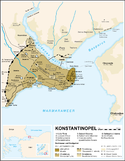Hieria — was *the name of an Eastern Orthodox saint Hieria of Mesopotamia (320) *a palace opposite Constantinople, on the Asian side of the Bosphorus between Chrysopolis and Chalcedon, the location of the Council of Hieria (754) … Wikipedia
Hieria — Suburb of Constantinople (q.v.), located on the Asiatic coast of the Bosporos (q.v.). An imperial palace located here was sometimes used for ceremonial purposes. The Council of Hiera (q.v.) took place here in 754 … Historical dictionary of Byzantium
Hieria, Council of — Convened by Constantine V (q.v.) in 754 to provide the dogmatic rationale for imperial decrees that ordered the destruction of icons (q.v.) and the excommunication of Iconophiles (q.v.). Constantine V packed the council with his supporters and … Historical dictionary of Byzantium
Council of Hieria — 40°58′22.7″N 29°2′36.7″E / 40.972972°N 29.043528°E / 40.972972; 29.043528 The iconoclast Council of Hieria was a Christian council which viewed itself as ecumenical, but was later rejected by the … Wikipedia
Iconoclasm (Byzantine) — Iconoclasm, Greek for image breaking , is the deliberate destruction within a culture of the culture s own religious icons and other symbols or monuments, usually for religious or political motives. It is a frequent component of major domestic… … Wikipedia
Iconoclasia — Una simple cruz: ejemplo de arte iconoclasta en la iglesia de Hagia Irene (Santa Irene) de Constantinopla. Iconoclasia, expresión que en griego significa «ruptura de imágenes», es la deliberada destrucción dentro de una cultura de los iconos… … Wikipedia Español
Christianity in the 8th century — Age of the Caliphs Expansion under Muhammad, 622–632/A.H. 1 11 … Wikipedia
History of Christianity — Church history redirects here. For the journal, see American Society of Church History#Church History. For the magazine, see Christianity Today#Christian History. Church historian redirects here. For LDS official church historian, see Church… … Wikipedia
Icon — This article is about the religious artifacts. For other uses, see Icon (disambiguation). The Ladder of Divine Ascent icon showing monks ascending to Jesus in Heaven, top right. 12th century, St. Catherine s Monastery … Wikipedia
Byzantine art — The most famous of the surviving Byzantine mosaics of the Hagia Sophia in Constantinople the image of Christ Pantocrator on the walls of the upper southern gallery. Christ is flanked by the Virgin Mary and John the Baptist. The mosaics were made… … Wikipedia

